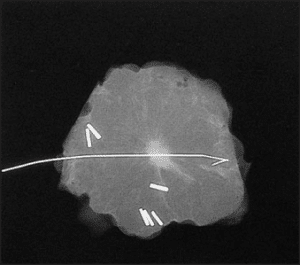The word lumpectomy literally means ‘removal of lump’. In the context of breast cancer, a breast lumpectomy means removal of the cancerous lump. A lumpectomy is also referred to as a ‘wide local excision’ (WLE) and it also falls under the term breast conservation surgery (BCS).
However, some breast cancers do not present as lumps and are instead diagnosed on mammograms or even an MRI. If these areas of abnormalities are small, they can also be removed without removing the whole of the breast. To assist removal of these non-palpable cancers, a radiologist will need to insert a thin wire (under local anaesthetic) to help the surgeon identify the area that needs to be removed (wire-guided wide local excision).
Surgery
A lumpectomy / WLE is usually performed as a day case. This means that you arrive for surgery in the morning and return home later the same day. If you need a wire localisation, this is normally done on the morning of surgery. The wire is inserted, under local anaesthetic, usually in the same department where you had your cancer biopsied. You will then return to the theatre area in preparation for your surgery.

This is an Xray image of a lumpectomy specimen after excision. You can see the thin wire that has been used to localise the cancer that is situated in the middle of the specimen.
Breast surgery is performed under general anaesthetic, and only under special circumstances (and very rarely) is it performed under local anaesthetic. This is usually only considered in patients who have significant co-morbidities and are considered high risk to undertake a general anaesthetic.
If you have been diagnosed with an invasive cancer, then you will also need to have a sentinel lymph node biopsy at the same time as your breast surgery.
Scars
The scars for these types of surgery are relatively small. The location of the cancer determines where the scar will be. The surgeon will determine the best aesthetic place for the scar and it can either be placed around the nipple-areola complex (the pigmented area of the nipple) or on the breast itself.
Recovery
Recovery from a lumpectomy is reasonably quick. The surgery itself does not take very long to do, around 60 – 90 minutes on average. Patients do not complain of much pain afterwards and if analgesia is needed you may only need to take it for a few days. For those who work, we normally recommend 2 weeks off, although the majority of women feel back to normal self far quicker than that.
What is re-excision surgery?
The aim of a lumpectomy / WLE is to remove the cancer with a good margin of healthy breast tissue. If after analysis by the pathologist it appears that the cancer is at or close to one of the edges/margins, then it is likely you will need to have another operation where more breast tissue will be removed. This is to ensure that all the margins are clear of cancer. This is usually scheduled a few weeks after you have been given the results. The same scar is usually re-opened and the surgery is less extensive and shorter in duration.
What is an axillary nodal clearance (ANC)?
You may need to have an axillary nodal clearance if cancer cells have been detected in your sentinel lymph nodes. Again, this will only be noted after analysis. This operation involves removal of all the glands from your axilla (armpit).
What happens afterwards?
After you have completed your surgery, further treatment may be needed. Depending on the results, you may need either chemotherapy or radiotherapy. Your surgeon will have this discussion with you once the results of your surgery become available.


